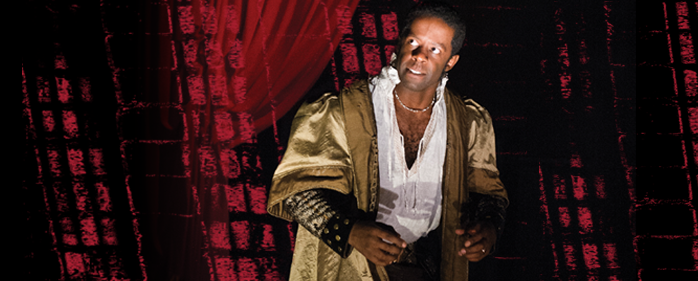I’d like to take almost everyone involved in a new Broadway show and bus them out to St. Ann’s Warehouse in Brooklyn. That’s where I– along with a first night audience that included no less than James Earl Jones, Mike Nichols, director Greg Mosher, composer Laurie Anderson, actors Dan Hedaya and Kathryn Grody, “Motown” musical director Charles Wright– all saw the best new play of the 2013-14 season. It’s called “Red Velvet,” stars Adrian Lester, and is more deserving of a home in the theater district than almost anything I’ve seen in the last nine months.
“Red Velvet” is brought to us by London’s very hot Tricycle Theater Company. Lester’s wife, Lolita Chakrabarti, wrote it. Indu Rubasingham directed it. If New York magazine is smart, they’ll get out there tomorrow and photograph these three people before they have publicists blocking everything. They, along with the rest of the “Red Velvet” cast, are the real theater stars of today.
Among the people who support the Tricycle, by the way, are Tim and Nina Zagat, and married actors Jim ( )– Mr. Carson, to you– and Imelda Staunton.
This is based on a true and great saga. Lester plays the very real Ira Aldridge, a black American actor popular in Europe in the early 1800s. In 1833, he made his London debut as Othello at Covent Garden at a proper theater with a white cast. He had a white wife, and a lot of baggage. But in Eastern Europe–Russia, Poland, Prague, Vienna– Aldridge’s color was ignored. In London, as it might have been in the U.S., it was not. The play deftly imagines, using accounts from the production and London newspapers, Aldridge’s entry into London’s theatre world.
“Red Velvet” already played in London twice. In between Lester, whom we know from the Mike Nichols movie “Primary Colors,” played Othello in a real Shakespeare production in London.
The play is set against the London riots of the time concerning slavery. It was as much an issue there as it was in the States.
Lester makes for a towering presence as Aldridge and as Othello, leading a hugely talented cast including Oliver Ryan as Charles Kean (son of the famed actor Edmund Kean, who is taken ill and replaced by Aldridge at the last minute); Charlotte Lucas, Eugene O’Hare, Rachel Finnegan (wonderful in three roles), Natasha Gordon, Nic Jackman, and Simon Chandler. Rubasingham has this group running like a well tuned clock. I haven’t had this much fun– and drama–with an ensemble since “Vanya and Sonia et al” debuted a Lincoln Center.
Of course, Aldridge’s plight is a tragic one, in that he thinks he’s defied social injustice by making himself an ex-pat. Like Othello, though, he is doomed.
I do like to make fun of Brooklyn– getting there, and where is it, and all that. But the truth is, the last really great theater experience I had was in that borough with Julie Taymor’s “Midsummer Night’s Dream.” “Red Velvet” has that rare sense of being fresh and new. It’s also complete– a real play, well built, in two solid acts that are meaningful. By the time it’s over, you’ve learned something, the characters have all progressed in some way, there is closure, and if not a happy ending, a satisfying one.
Bravo! With any luck, “Red Velvet” will get a chance to come to Broadway under the right auspices. For now, though, we’ll be satisfied to say we saw it “when.” Not if, or then.

